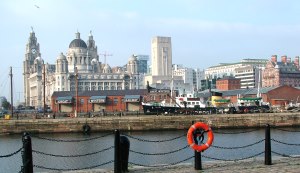Liverpool: A history of struggle
 In
1323 Liverpool built a castle. It was used by Edward III
as a staging post for his war on Scotland.
In
1323 Liverpool built a castle. It was used by Edward III
as a staging post for his war on Scotland.
In 1327 it all backfired and the castle
was used to shelter them fleeing back from the Scots.
It was knocked down to build a church in
1715 at the same time as Bonnie Prince Charlie’s
dad was on a bit of an adventure to take over Scotland
again.
Anyway, we won’t hold it against them,
other than to mention that Edinburgh (unlike Glasgow)
has got a castle - and of course that Liverpool is facing
a legal battle over a failed tram thingummy.
So many parallels to draw, eh?
Global city
The city grew from global trade, and sadly
also from the profits of slavery just like Scotland’s
trading cities.
It became famous in modern times the world
over for the Beatles and the other Merseybeat phenomena.
But before that it also grew as a hotbed
of working class struggle.
A struggle with international roots as the port became
a melting pot for English, Irish, Scots and new Liverpudlians
from around the world.
Its Chinatown is the oldest in Britain and
the black community can trace its roots back to the 18th
century.
The famous dock strikes of 1911 and 1995-98
are well documented.
Liverpool saw a police strike in 1919 and a major role
in the 1926 general strike.
The North West also saw great injustice
in the building workers’ strike of 1972 that still
leaves actor Ricky Tomlinson fighting to clear his name
from the conspiracy that unjustly jailed workers like
him at the time.
Sadly, the 1980s brought unrest in Toxteth
bred out of poverty, racism and marginalisation.
Then there was the controversial period
from 1983-87 when the Militant dominated Labour council
set an illegal budget against cuts. Nalgo member Derek
Hatton was the leader and how the venture imploded is
a longer story than we have room for here - other than
to say that the union faced enormous and bitter challenges.
And of course, iconic trade union leader
Jack Jones hailed from these parts. A man who, as the
city’s youngest councillor, went off to Spain in
1937 to fight against fascism in the civil war and spent
his long life fighting injustice.
Football
Liverpool is also the home of two iconic
football teams that rose out of one.
Everton and Liverpool live across a park from each other
and the rivalry is intense. But so is the working class
solidarity.
Everton fans stood with Liverpool fans to
fight the 23 year insult to working class people of establishment
lies and demonisation following the deaths of 96 innocent
supporters in the Hillsborough tragedy.
Eating out
In recent years Liverpool has seen a huge
transformation, especially in the Waterfront area where
the Conference will be held.
Bars and restaurants are all nearby but
venture inland for a wider variety. We’ll be seeking
some recommendations from our North West colleagues.
Scouse
And you can’t go without tasting Scouse
- the dish the Scousers are named after - or vice versa.
Many variations are to be found of this
warming stew. No further comment is wise from a nation
that has sheep’s innards and turnips as its national
dish.
Liverpool is also famous for Steve Gray
from the Aberdeenshire Branch. After many years in the
land of the North East, he has kept the strongest Merseyside
accent you’ll hear at Conference.
So much so that some hearing him announce
himself at Scottish Council as ‘Steve Gray, Aberdeenshire
Branch’, think that Scouse is the Doric.



